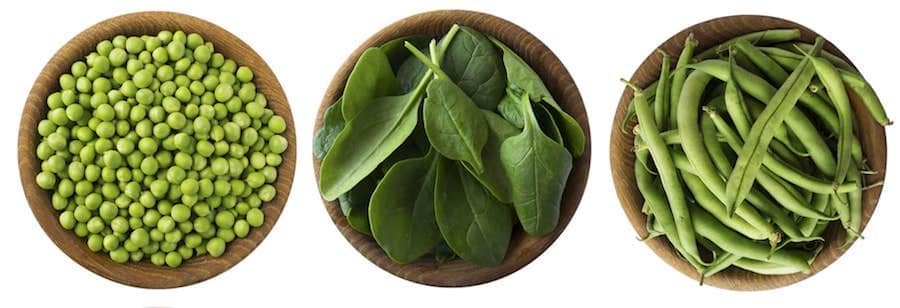Learn : Food & Nutrition
Fiber and The Microbiome
If you are what you eat, the fiber in your diet would make you a broom. Fiber is probably best known for keeping our intestines clean and regular. It also has many health benefits that protect us from some chronic diseases. But what is it exactly?
Fiber is a type of carbohydrate that the body can’t digest1.
If I can’t digest it, why do I need it, you ask? Well, while most carbohydrates can be broken down into sugars, like a stack of Legos taken apart piece by piece, most animals cannot digest fiber on their own and rely on gut bacteria to handle the task. Some members of our microbiota use this fiber as a source of energy and thrive in the gut when it is part of our diet2. Additionally, a by-product of this breakdown is actually important for our own metabolism and health, called short-chain fatty acids3.
Fiber is found in a number of different foods. While certain types of beans may make you gassy, they are a great source of fiber. But if you’d rather skip the gas, fruits, vegetables, and whole grains are excellent replacements1. Dogs and cats similarly get fiber from their food4, as it is usually included in most commercial diets5.
How does consuming fiber help animals? Why is it so beneficial?
Soluble vs Insoluble Fiber6,7
There are two main types of dietary fiber: one that can dissolve in water and one that can’t.
Soluble fiber essentially turns into a gel when it dissolves in water during digestion. This slows the process down and helps our intestines absorb excess water. It is typically found in cooked grains, beans, fruits, and root vegetables. A common fiber supplement called psyllium falls into this category.
Insoluble fiber, on the other hand, speeds digestion up and helps move all material towards the opposite end. Its role is to “bulk up” stool, which makes it larger and puts pressure on the walls of the intestines – giving you the signal that it’s time for a trip to the bathroom. This type is typically what is recommended when you are suffering from constipation. Whole grains, nuts, and vegetables are good sources of insoluble fiber.
Most whole food fiber sources (think beans, beet pulp, and vegetables) are great sources of both soluble and insoluble fiber. Getting your fiber from a variety of different foods can help ensure that you are receiving a healthy balance of the two types and will be better for your overall health.
in Human Health and Disease8
Including fiber as part of a healthy diet has been linked to many important health benefits. In addition to helping with constipation, fiber has been shown to reduce the risk of diseases such as heart disease, strokes, and diabetes.
Cardiovascular diseases are the leading cause of death in the United States. More than 600,000 deaths every year are caused by heart disease and strokes cause over 100,0009,10. However, higher levels of dietary fiber are linked to lower prevalence rates for many of these diseases. Most major risk factors are also lower in people who consume high amounts of fiber. Studies have shown that soluble fiber decreases “bad” cholesterol levels, which greatly decreases the risk developing cardiovascular conditions.
Diabetes and obesity rates have also skyrocketed around the globe, but consuming high amounts of dietary fiber has been correlated with lower risk. Consuming whole grains may be protective against obesity and fiber could help improve controlling blood sugar levels in individuals at risk for diabetes.
Fiber and the Microbiome2
Animal microbiomes are complex and diverse communities that are susceptible to changes in diet11-13. For example, as human diets have shifted towards processed and refined foods, our microbiomes have also changed - becoming less diverse over time. A study evaluating canines has also that wolves and domesticated dogs14 have different microbiomes. While this was not linked to diet, wolves often consume a different diet typically depleted of fiber, while dogs have adapted to a diet and may benefit from its inclusion15,16.
Decreases in microbial diversity have been associated with lower fiber intake17. A study in hibernating bears found that bacteria using fiber as an energy source increased in the microbiome in late spring, but disappeared during hibernation when the bear utilizes alternative energy reserves18.
In humans, the microbiome can respond to dietary changes within 24 hours. People fed plant-based diets experienced a rapid increase in bacterial communities that thrive on fiber19.
Dietary Fiber in Dogs and Cats
Although not a dietary requirement, our pets get many of the same benefits4 from fiber as we do. For example, it helps with digestion4 and is useful for managing a healthy weight20,21. Beet pulp and cellulose, a component of plant cells, are common sources of dietary fibers used in commercial pet foods5. Beet pulp is composed of both insoluble and soluble fibers, while cellulose is primarily insoluble.
Numerous studies have been conducted in both dogs and cats evaluating the effectiveness of fiber in their diet. Similar to humans, researchers have discovered that fiber improves food digestion and alters microbiome5. Diabetic dogs4,22 may also benefit from high-fiber diets, although the effects appear to vary between individual animals.
Incorporating fiber into your pet’s diet can also feed their microbiome and change its composition23,24. Even small amounts16 have resulted in detectable changes, which could help animals with diseases linked to microbial imbalances in the gut.
More research remains to be done to determine the best fiber plans for our companion animals. What is the role of the bacteria that benefit from dietary fiber? How does their metabolism change in response to the by-products released by bacteria that are breaking it down? However, in the meantime the benefits are clear - their intestines can be swept clean (i.e. kept healthy) with some fiber in their food.
References
1. Fiber. The Nutrition Source (2012). Available at: https://www.hsph.harvard.edu/nutritionsource/carbohydrates/fiber/. (Accessed: 5th December 2018)
2. Makki, K., Deehan, E. C., Walter, J. & Bäckhed, F. The Impact of Dietary Fiber on Gut Microbiota in Host Health and Disease. Cell Host Microbe 23, 705–715 (2018).
3. Chambers, E. S., Preston, T., Frost, G. & Morrison, D. J. Role of Gut Microbiota-Generated Short-Chain Fatty Acids in Metabolic and Cardiovascular Health. Curr. Nutr. Rep. 7, 198–206 (2018).
4. Finlay, K. Benefits of High-Fiber Dog Foods. American Kennel Club (2018). Available at: https://www.akc.org/expert-advice/nutrition/benefits-high-fiber-dog-foods/. (Accessed: 5th December 2018)
5. de Godoy, M. R. C., Kerr, K. R. & Fahey, G. C., Jr. Alternative dietary fiber sources in companion animal nutrition. Nutrients 5, 3099–3117 (2013).
6. , T. D. A Tale of Two Fibers. US News & World Report (2013). Available at: https://health.usnews.com/health-news/blogs/eat-run/2013/06/25/a-tale-of-two-fibers. (Accessed: 5th December 2018)
7. How to add more fiber to your diet. Mayo Clinic (2018). Available at: https://www.mayoclinic.org/healthy-lifestyle/nutrition-and-healthy-eating/in-depth/fiber/art-20043983. (Accessed: 5th December 2018)
8. Anderson, J. W. et al. Health benefits of dietary fiber. Nutr. Rev. 67, 188–205 (2009).
9. Heart Disease Facts & Statistics | cdc.gov. (2018). Available at: https://www.cdc.gov/heartdisease/facts.htm. (Accessed: 5th December 2018)
10. FastStats. (2018). Available at: https://www.cdc.gov/nchs/fastats/leading-causes-of-death.htm. (Accessed: 5th December 2018)
11. Coelho, L. P. et al. Similarity of the dog and human gut microbiomes in gene content and response to diet. Microbiome 6, 72 (2018).
12. Conlon, M. A. & Bird, A. R. The impact of diet and lifestyle on gut microbiota and human health. Nutrients 7, 17–44 (2014).
13. Kim, J., An, J.-U., Kim, W., Lee, S. & Cho, S. Differences in the gut microbiota of dogs (Canis lupus ) fed a natural diet or a commercial feed revealed by the Illumina MiSeq platform. Gut Pathog. 9, 68 (2017).
14. Wu, X. et al. Analysis and comparison of the wolf microbiome under different environmental factors using three different data of Next Generation Sequencing. Sci. Rep. 7, 11332 (2017).
15. Miller, R. Adding Fiber to Your Dog’s Diet - The Dogington Post. The Dogington Post (2013). Available at: http://www.dogingtonpost.com/adding-fiber-to-your-dogs-diet/. (Accessed: 5th December 2018)
16. Middelbos, I. S. et al. Phylogenetic characterization of fecal microbial communities of dogs fed diets with or without supplemental dietary fiber using 454 pyrosequencing. PLoS One 5, e9768 (2010).
17. Sonnenburg, E. D. et al. Diet-induced extinctions in the gut microbiota compound over generations. Nature 529, 212–215 (2016).
18. Sommer, F. et al. The Gut Microbiota Modulates Energy Metabolism in the Hibernating Brown Bear Ursus arctos. Cell Rep. 14, 1655–1661 (2016).
19. David, L. A. et al. Diet rapidly and reproducibly alters the human gut microbiome. Nature 505, 559–563 (2014).
20. Pallotto, M. R., de Godoy, M. R. C., Holscher, H. D., Buff, P. R. & Swanson, K. S. Effects of weight loss with a moderate-protein, high-fiber diet on body composition, voluntary physical activity, and fecal microbiota of obese cats. Am. J. Vet. Res. 79, 181–190 (2018).
21. German, A. J., Holden, S. L., Bissot, T., Morris, P. J. & Biourge, V. A high protein high diet improves weight loss in obese dogs. Vet. J. 183, 294–297 (2010).
22. Graham, P. A., Maskell, E., Rawlings, J. M., Nash, A. S. & Markwell, P. J. of a high diet on glycaemic control and quality of life in dogs with diabetes mellitus. J. Small Anim. Pract. 43, 67–73 (2002).
23. Kerr, K. R., Forster, G., Dowd, S. E., Ryan, E. P. & Swanson, K. S. Effects of dietary cooked navy bean on the fecal microbiome of healthy companion dogs. PLoS One 8, e74998 (2013).
24. Panasevich, M. R. et al. Modulation of the faecal microbiome of healthy adult dogs by inclusion of potato fibre in the diet. Br. J. Nutr. 113, 125–133 (2015).



 Microbiome in Nutrition
Microbiome in Nutrition
 Microbiome And Its Relationship To Health
Microbiome And Its Relationship To Health
 Evolution of Microbiome Research
Evolution of Microbiome Research
 What Does a Balanced Diet for Dogs Include?
What Does a Balanced Diet for Dogs Include?
 Probiotics and Pet Health
Probiotics and Pet Health